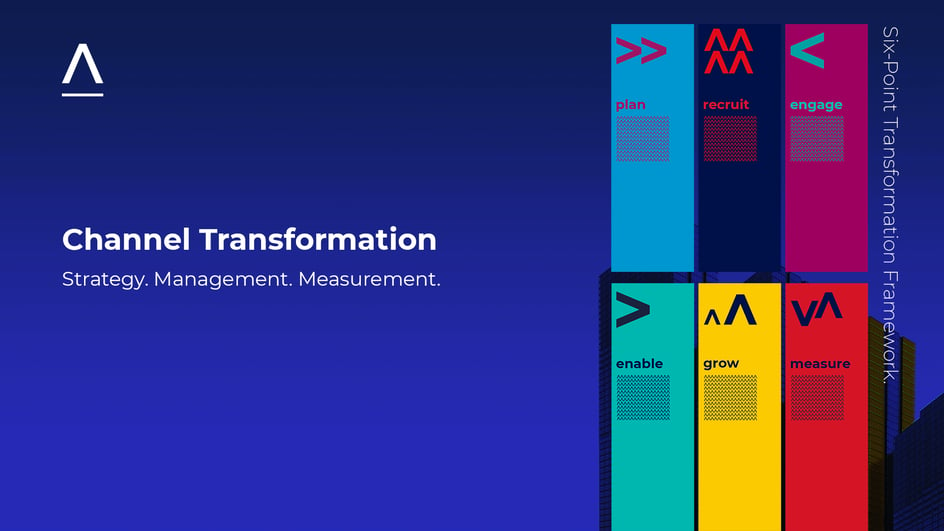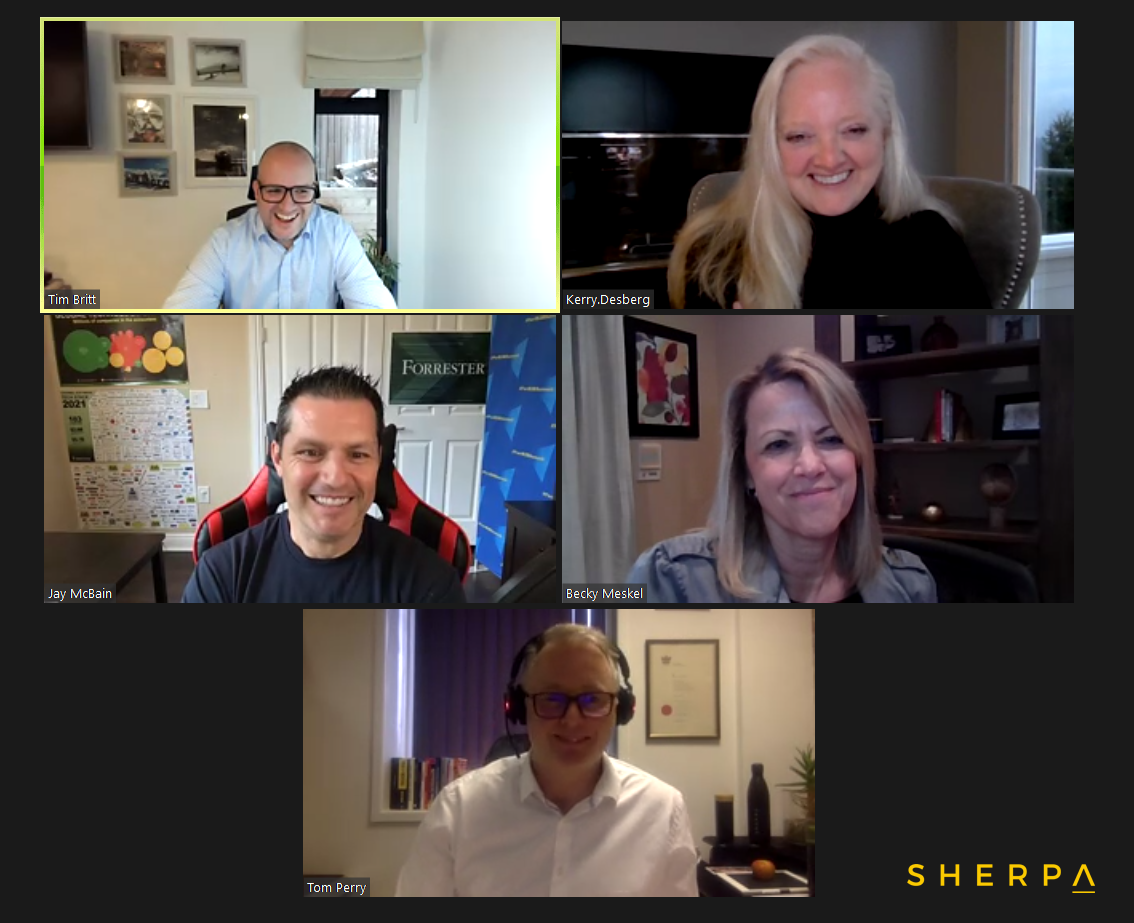The Future of Partner Marketing: 6 Takeaways from the webinar Webinar
Partner marketing is entering a new era.
5 min read
 Annee Sian
Dec 18, 2020 3:42:15 PM
Annee Sian
Dec 18, 2020 3:42:15 PM

As the close of 2020 approaches, we took some time with our CEO Tom Perry, to look back on our experiences as a specialist channel agency and what we’ve learned – about channel, about our business, about our clients globally – and crucially, to begin to look forward and map out what channel might look like in 2021.
So many business plans went out of the window in 2020. What lessons did Sherpa learn?
For Sherpa, our Vendor clients and for almost every business globally, 2020 has been a challenging year. Although faring better than some other sectors, tech has had to adapt fast with questions raised about what is really needed and what actually works.
As a business, we learned that we needed to be more streamlined, we needed to communicate more – with staff, suppliers, and clients – and, above all, we needed to review our operations. I think that’s been exactly the same for the channel and our Vendors too. The main lesson we’ve learned in 2020 is that it’s possible to be a better business. Yes, there’s been an element of survival – and I know that’s been true for a lot of channel Partners too – but it’s possible to come out of 2020 in better shape than we thought back at the beginning of April when it all looked pretty bleak.
Sherpa launched the concept of Channel Transformation in 2020. What is it and where are we on this mission?
Over the course of 2018 and 2019, working with 30 of the world’s largest tech Vendors, we realised that there was a groundswell in this direction, where they were ready to reconsider the channel model they operated under. Most of those traditional models hadn’t changed for 30 years. They were quarterly focused, MDF always played a part as did the need for Partners to upskill and pay for accreditation, and the model suited a very traditional type of Partner, which we know was becoming limiting. A lot of the larger Vendors were questioning whether the old models would work as their channels developed. Alongside that, you had analyst firms like Forrester, Gartner and IDC predicting that a new channel model was coming.
In our day-to-day relationships with Vendors, especially the bigger ones, we were seeing first-hand, an increasing appetite for change; to transform their channel operations – across marketing, recruitment, enablement, strategy planning, and measurement - indeed all the elements of a channel operation. So we came up with the umbrella concept of ‘Channel Transformation’ to encapsulate a better way for Vendors to work with their channels.

We launched Channel Transformation in beta mode, at the end of 2019. Obviously, we know what then happened in March 2020. Yet we found the concept resonated with those Vendors who had been considering the journey, and so we came up with our Channel Transformation Growth Assessment Tool, where Vendors could answer a series of questions to measure themselves on how advanced they were in a number of key areas of channel operations. We’ve had a good, steady flow of people completing that in 2020 and so we know that there is a movement of Vendors looking at channel transformation. It has caught the imagination of Vendors who know that things are going to change, and actually the ‘Covid year’ has accelerated some of those thoughts amongst those Vendor groups.
What are tech Vendors’ biggest channel challenges and objectives for 2021?
The biggest objectives for 2021 seem to be around quickly examining your existing channel and looking at the white space that exists within it, but also at how you can build a more complete channel for the different operating models that a lot of Vendors have.
The number one objective for 2021 is looking at the make-up of channel. A really great example of this is IBM and Salesforce, two of the largest tech vendors in the world. Both have embarked on bringing different types of partners into their ecosystems and then managing them very differently than they would have done say, two or three years ago.
The second, and I think even more important objective, is that once you know what kind of channel you need, you’ve got to look at how you support it for the years ahead, and 2021 will be a key year for the models of support that large tech companies give their channels and their go-to-market partners. Changing it up is really, really important.
I predict there are going to be a large number of different and new Partner types and so different models of support. It’s not going to be a percentage of revenue given back in marketing support or funded heads embedded in or free accreditation. Like I said earlier, that’s yesterday’s model. We’re moving to there being different levels of transactional support. I think also, those larger Partners who have weathered the storm and are coming out of 2020 in good shape, are going to get more support in terms of resource and funding as we move through 2021, because they work well in this new model.
You’ve mentioned IBM and Salesforce are already understanding this need for channel transformation. Are there any other companies that you’ve been impressed with?
Yes, a couple of clients of ours. Certainly, we’ve seen a different direction from Sage. They’ve looked at the different types of Partner and have created their own marketplace for all types. It’s been a big initiative that’s taken time to get to, but it provides them with a framework for 2021 and beyond. Another client we’ve been talking to around this is Verizon, a global player in various tech areas. They’ve looked at the models of support they need to give their Partners and are working on joint value propositions, a joint go-to-market and a funding model that means everybody is involved and is focused on growing revenues beyond 2020. This long-term focus is good to see.
Looking forward to 2021, what are some of the bigger initiatives and projects that Sherpa is supporting Vendors with?
One area that we as a specialist channel agency are being asked to get involved in, within the shorter-term, is helping Vendors assess and evaluate the channel they’ve got in place today. That’s number one, and is an exercise that we’ve been through with a number of our Vendors.
Number two is evaluating whether Partner programmes are fit for purpose or need adapting for a new model. Then the third area that is emerging, is that the year we’ve had in 2020 has accelerated Vendors needing to recruit different types of partners. A lot of them are coming to the end of this year with the concern that their channel is not quite in the shape it needs to be to deliver their revenue goals from channel over the next couple of years.
And finally, this year has really shone a light on some of the limitations of a lot of the Partner and channel-based software platforms out there. That technology has been around 10 to 15 years and whilst it’s served clients well to date, it’s not able to deal with the volume of different types of Partners operating today. In our Platforms division here at Sherpa, we’ve had to develop platforms around MDF, application management, visibility, partner communication and what we’ve seen in the marketplace is a specialist company like Sherpa filling the gaps that the current providers aren’t able to.
What industry trends or research are you seeing that resonates with Vendors, and who are you seeing it from?
That’s a good question, and for me this year it’s Forrester, a leading channel analyst company. Their channel practice led by Jay McBain has had what looks like a crazy year delivering his Future of Channel talk. They’ve realised that things are changing, and changing fast and that the wider market needs to be told about this. We do our own research too, which has helped to position Sherpa as an agency dedicated to supporting channel only.
Through a couple of clients, we’ve also engaged with IDC and Margaret Adam who, certainly in the first half of 2020, was very good on the stages of strategy and growth, and the business activities that the channel would need to go through to get out of a challenging year. So those would be my go-to people for the year.
So there we have it; 2020 has been an enormously challenging year within tech, and for channel within that. With those challenges, people have had time to stop and reflect on the business models that are going to take them forward for the next few years. With that market movement, Vendors and channels alike need to adapt their operations, but if this year has taught us anything, it’s that businesses can and should change. There is a future out there, post-Covid, where we can return to the levels of growth that we enjoyed prior to the pandemic. Indeed the future looks bright for those who want to transform.

Partner marketing is entering a new era.

Partner marketing isn’t just evolving, it’s accelerating. With buying committees now stretching to 20+ decision-makers, AI reshaping how we work, and...


It was a pleasure to host and see so many dial in to Sherpa’s State of Channel 2022 Panel discussion featuring: Host: Jay McBain, Forrester Research ...

2020 shone a bright light on the technology channel and as a result of a tough year, many Vendors are concerned that their channel is not quite in...

We welcomed Channel Vendors, small and large, to the second Virtual Channel Chat. Each with different strategies and opinions on how best to move...